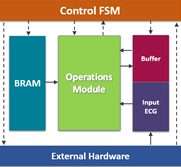Arquitectura Computacional para la Inferencia de una CNN Cuantizada para Detectar Fibrilación Auricular
Main Article Content
Keywords
Detección automática, Fibrilación auricular, Implementación en FPGA, Red Neuronal Convolucional Cuantizada
Resumen
La fibrilación auricular es una arritmia cardíaca común, que se caracteriza por un ritmo cardíaco anormal que puede poner en peligro la vida. Recientemente, se han propuesto varias Redes Neuronales Convolucionales (CNNs, por sus siglas en inglés) para detectar la fibrilación auricular. Las CNN tienen altos requisitos de recursos informáticos y de memoria, lo que generalmente demanda el uso Computación de Altro Rendimiento como por ejemplo GPUs. Esta alta demanda de energía es un desafío para los dispositivos portátiles. Por lo tanto, se requieren implementaciones de hardware eficientes. Proponemos una arquitectura computacional para la inferencia de una Red Neural Convolucional Cuantizada (Q-CNN) que permite la detección de la Fibrilación Auricular (FA). La arquitectura aprovecha el paralelismo a nivel de datos, incorporando unidades vectoriales basadas en SIMD, que están optimizadas en términos de cálculo y almacenamiento. El diseño también se optimizó para realizar tanto las capas convolucionales como las capas completamente conectadas. La arquitectura computacional se implementó y probó en una FPGA Xilinx Artix-7. Presentamos los resultados experimentales con respecto al proceso de cuantización en un número diferente de bits, recursos de hardware y precisión. Los resultados muestran una precisión del 94% para 22 bits. Este trabajo pretende ser la base para la futura implementación de un dispositivo portátil, de bajo costo y alta confiabilidad para el diagnóstico de Fibrilación Auricular.
Descargas
Referencias
[2] A. Y. Hannun, P. Rajpurkar, M. Haghpanahi, G. H. Tison, C. Bourn, M. P. Turakhia, and A. Y. Ng, “ Cardiologist-level arrhythmia detection and classification in ambulatory electrocardiograms using a deep neural network,” Nature Medicine, vol. 25, no. 1, pp. 65–69, 2019. http://dx.doi.org/10.1038/s41591-018-0268-3
[3] P. A. Warrick and M. Nabhan Homsi, “ Ensembling convolutional and long short-term memory networks for electrocardiogram arrhythmia detection,” Physiological Measurement, vol. 39, no. 11, 2018. http://dx.doi.org/10.1088/1361-6579/aad386
[4] Z. Xiong, M. P. Nash, E. Cheng, V. V. Fedorov, M. K. Stiles, and J. Zhao, “ ECG signal classification for the detection of cardiac arrhythmias using a convolutional recurrent neural network,” Physiological Measurement, vol. 39, no. 9, 2018. http://dx.doi.org/10.1088/1361-6579/aad9ed
[5] T. Mahmud, S. A. Fattah, and M. Saquib, “Deeparrnet: An efficient deep cnn architecture for automatic arrhythmia detection and classification from denoised ecg beats,” IEEE Access, vol. 8, pp. 104 788–104 800, 2020. http://dx.doi.org/10.1109/ACCESS.2020.2998788
[6] Song Han, “ Efficient methods and hardware for deep learning,” Ph.D. disser- tation, Stanford University, 2017.
[7] D. Gschwend, “Zynqnet: An fpga-accelerated embedded convolutional neural network,” 2020. https://arxiv.org/pdf/2005.06892.pdf
[8] Y. Ma, Y. Cao, S. Vrudhula, and J. S. Seo, “ Optimizing loop operation and dataflow in FPGA acceleration of deep convolutional neural networks,” FPGA 2017 - Proceedings of the 2017 ACM/SIGDA International Symposium on Field-Programmable Gate Arrays, pp. 45–54, 2017. https://doi.org/10.1145/3020078.3021736
[9] J. Yu, Y. Hu, X. Ning, J. Qiu, K. Guo, Y. Wang, and H. Yang, “ Instruction driven cross-layer CNN accelerator with winograd transformation on FPGA,” 2017 International Conference on Field-Programmable Technology, ICFPT 2017, vol. 2018-Janua, pp. 227–230, 2018. https://doi.org/10.1109/ FPT.2017.8280147
[10] S. Sağlam, F. Tat, and S. Bayar, “Fpga implementation of cnn algorithm for detecting malaria diseased blood cells,” in 2019 International Symposium on Advanced Electrical and Communication Technologies (ISAECT). IEEE, 2019, pp. 1–5. http://dx.doi.org/10.1109/ISAECT47714.2019.9069724
[11] S. Zhang, J. Cao, Q. Zhang, Q. Zhang, Y. Zhang, and Y. Wang, “An fpga-based reconfigurable cnn accelerator for yolo,” in 2020 IEEE 3rd International Conference on Electronics Technology (ICET). IEEE, 2020, pp. 74–78. http://dx.doi.org/10.1109/ICET49382.2020.9119500
[12] E. Wang, J. J. Davis, R. Zhao, H.-C. Ng, X. Niu, W. Luk, P. Y. Cheung, and G. A. Constantinides, “Deep neural network approximation for custom hardware: Where we’ve been, where we’re going,” ACM Computing Surveys (CSUR), vol. 52, no. 2, pp. 1–39, 2019. https://doi.org/10.1145/3309551
[13] S. Mittal, “A survey of fpga-based accelerators for convolutional neural networks,” Neural computing and applications, vol. 32, pp. 1109–1139, 2020. https://doi.org/10.1007/s00521-018-3761-1
[14] J. A. Castillo, Y. C. Granados, and C. A. Fajardo, “ Patient-Specific Detection of Atrial Fibrillation in Segments of ECG Signals using Deep Neural Networks,” Ciencia E Ingenieria Neogranadina, vol. 30, no. 1, 2020. https://doi.org/10.18359/rcin.4156
[15] W. Uribe, M. Duque, and E. Medina, “Electrocardiografía y arritmias, ”Clínica Medellín. Editorial PLA Export Bogotá DC, pp. 41–5, 2005.
[16] H. Li, X. Fan, L. Jiao, W. Cao, X. Zhou, and L. Wang, “ A high performance FPGA-based accelerator for large-scale convolutional neural networks. ”EPFL, Aug 2016, pp. 1–9. https://doi.org/10.1109/FPL.2016.7577308
[17] A. Tisan, S. Oniga, D. MIC, and A. Buchman, “ Digital Implementation of The Sigmoid Function for FPGA Circuits,” Acta Technica Napocensis, vol. 50, no. 2, pp. 15–20, 2009.
[18] A. Goldberger, “ MIT-BIH atrial fibrillation database,” 2000. https://physionet.org/content/afdb/1.0.0/
[19] B. Jacob, S. Kligys, B. Chen, M. Zhu, M. Tang, A. Howard, H. Adam, and D. Kalenichenko, “ Quantization and Training of Neural Networks for Efficient Integer-Arithmetic-Only Inference,” Proceedings of the IEEE Computer Society Conference on Computer Vision and Pattern Recognition, pp. 2704–2713, 2018. https://doi.org/10.1109/CVPR.2018.00286
[20] Y. Dong, R. Ni, J. Li, Y. Chen, H. Su, and J. Zhu, “ Stochastic Quantization for Learning Accurate Low-Bit Deep Neural Networks,” International Journal of Computer Vision, vol. 127, no. 11, pp. 1629–1642, 2019. https://doi.org/10.1007/s11263-019-01168-2
M. Nagel, R. Amjad, M. Baalen, C. Louizos, and T. Blankevoort, “ Up or Down ? Adaptive Rounding for Post-Training Quantization,” 2020. https://arxiv.org/pdf/2004.10568.pdf

